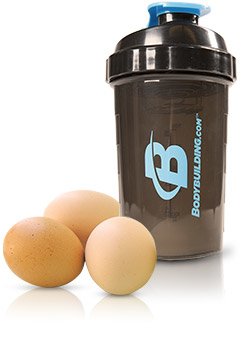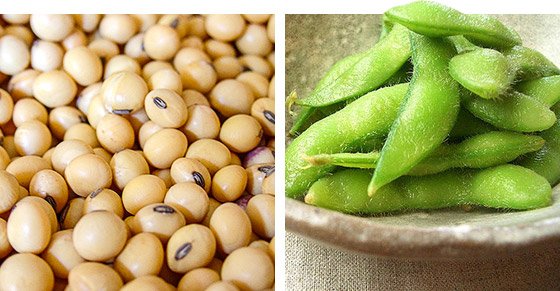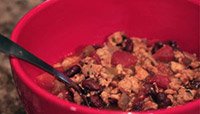
Why Women Need Protein!
Find out more about protein, and why it's so important for women.

Thanks to high-protein diets for weight loss, there has been an explosion of interest in protein. No longer are people looking at carbohydrates for shedding weight, or low-fat diets for trimming our thighs; protein has the spotlight.
I was under the impression that animal protein was hard on my body, but now, through my own experience and after doing some research of my own, I am confident that eating a balanced diet that includes one gram of protein per pound of body weight is safe and right for me.
Much of my protein sources include chicken, fish, eggs, and whey, and I enjoy the odd steak here and there. In the past I ate only fish and eggs, swearing off chicken. Whatever you choose to eat, please be sure that you have a diet that includes adequate amounts of protein.
What Is Protein?
Our weight is made up of about 75 percent protein. It is in virtually every body part or tissue, including our muscles, bone, skin, and hair.
Amino acids or "building blocks" provide the raw material for all proteins.

If you want to get scientific, guided by genetic instructions, the body strings together amino acids. Some genes require short chains; others are blueprints for long chains that fold, origami-like, into intricate, three-dimensional structures.
The body doesn't store amino acids, like it does fats or carbohydrates. The body needs a daily supply of amino acids to make new protein.
An impressive 10,000 different proteins make you what you are and keep you that way.
All Protein Isn't Alike
This may be review for some of you, but let's do a quick refresher on the facts. There are two types of proteins.
- Complete proteins: Protein that contains all the amino acids needed to build new proteins. Animal proteins tend to be complete.
- Incomplete proteins: Other protein sources which lack one or more amino acids that the body can't make from scratch or create by modifying another amino acid. Fruits, vegetables, grains, and nuts tend to be incomplete proteins.
Protein & Disease
Cardiovascular Disease
According to The Nurses' Health Study, which has investigated the association between dietary protein and heart disease or stroke, women who ate the most protein (about 110 grams per day) were 25 percent less likely to have had a heart attack or to have died of heart disease than the women who ate the least protein (about 68 grams per day) over a 14-year period.1
Whether the protein came from animals or vegetables or whether it was part of low-fat or higher-fat diets didn't seem to matter. These results offer reassurance that eating a lot of protein doesn't harm the heart. In fact, it is possible that eating more protein while cutting back on easily digested carbohydrates may benefit the heart.
A Look At Soy
One protein source that has been getting a lot of attention are soybeans. Some research suggests that regularly eating soy-based foods may:
- lower cholesterol
- chill hot flashes
- reduce risk of breast and prostate cancer
- aid weight loss
- ward off osteoporosis.2

These effects may be due to the soybeans' high concentrations of isoflavones. Isoflavones are a type of plant-made estrogen. This research has prompted media reports claiming many benefits of soy. It also has food makers pumping out new soy products that are beginning to move into the mainstream.
In Boston, for example, soymilk is now advertised on the radio during Boston Red Sox games, alongside donuts, oil additives, and beer.
Many of the claims made for soy may go far beyond the available evidence.
Hot Flashes
Soy has also been investigated as a treatment for hot flashes along with other problems that often accompany menopause. Soybeans are rich in plant estrogens, also called phytoestrogens. These substances mimic the action of estrogen. So they could cool hot flashes by giving a woman an estrogen-like boost during a time of dwindling estrogen levels. Yet carefully controlled studies haven't found this to be the case.3, 4
Breast Cancer
In some tissues, phytoestrogens block the action of estrogen. If this occurs in breast tissue, then eating soy could reduce the risk of breast cancer because estrogen stimulates the growth and multiplication of breast and breast cancer cells. However, so far studies haven't provided a clear answer.
Some studies show a benefit, while others show no association between soy consumption and breast cancer.2 In fact, a handful of unsettling reports suggest that concentrated supplements of soy proteins may stimulate the growth of breast cancer cells.5, 6 Large prospective studies now underway should offer better information regarding soy and breast cancer risk.
Memory & Thinking Ability
A few studies have raised the possibility that eating soy could help prevent the age-related loss of memory or decline in cognitive function. Two recent trials have yielded contradictory results in this area, with one showing a benefit for soy and another showing no benefit.7,8
Others go further, and suggest that too much soy could lead to memory problems. Among older women of Japanese ancestry living in Hawaii, those who relied on the traditional soy-based diet were more likely to have cognitive problems than those who switched to a more Western diet.9

The Final Word
Get A Good Mix Of Proteins
Eating a variety of foods will ensure that you get all of the amino acids you need.
Pay Attention To The Protein Package
You rarely eat straight protein. If you eat meat, steer yourself toward the leanest cuts. If you like dairy products, skim or low-fat versions are healthier choices. Beans, soy, nuts, and whole grains offer protein without much saturated fat and with plenty of healthy fiber and micronutrients.
Balance Carbohydrates and Protein
Cutting back on highly processed carbohydrates and increasing protein improves levels of blood triglycerides and HDL, and so may reduce your chances of having a heart attack, stroke, or other form of cardiovascular disease.
It may also make you feel full longer, and stave off hunger pangs. Too much protein, though, could weaken bones.
Eat Soy In Moderation
Soybeans, tofu, and other soy-based foods are an excellent alternative to red meat. But don't go overboard. Two to four servings a week is a good target. And stay away from supplements that contain concentrated soy protein or soy extracts, such as isoflavones. Larger amounts of soy may soothe hot flashes and other menopause-associated problems, but the evidence for this is weak.
Dietary Sources Of Protein |
|||||
| Food | Serving | Weight In Grams | Protein Grams | % Daily Value | |
| Hamburger, extra lean | 6 ounces | 170 | 48.6 | 97 | |
| Chicken, roasted | 6 ounces | 170 | 42.5 | 85 | |
| Fish | 6 ounces | 170 | 41.2 | 82 | |
| Tuna, water-packed | 6 ounces | 170 | 40.1 | 80 | |
| Beefsteak, broiled | 6 ounces | 170 | 38.6 | 77 | |
| Cottage cheese | 1 cup | 225 | 28.1 | 56 | |
| Cheese pizza | 2 slices | 128 | 15.4 | 31 | |
| Yogurt, low fat | 8 ounces | 227 | 11.9 | 24 | |
| Tofu | 1/2 cup | 126 | 10.1 | 20 | |
| Lentils, cooked | 1/2 cup | 99 | 9 | 18 | |
| Skim milk | 1 cup | 245 | 8.4 | 17 | |
| Split peas, cooked | 1/2 cup | 98 | 8.1 | 16 | |
| Whole milk | 1 cup | 244 | 8 | 16 | |
| Lentil soup | 1 cup | 242 | 7.8 | 16 | |
| Kidney beans, cooked | 1/2 cup | 87 | 7.6 | 15 | |
| Cheddar cheese | 1 ounce | 28 | 7.1 | 14 | |
| Macaroni, cooked | 1 cup | 140 | 6.8 | 14 | |
| Soymilk | 1 cup | 245 | 6.7 | 13 | |
| Egg | 1 large | 50 | 6.3 | 13 | |
| Whole-wheat bread | 2 slices | 56 | 5.4 | 11 | |
| White bread | 2 slices | 60 | 4.9 | 10 | |
| Rice, cooked | 1 cup | 158 | 4.3 | 9 | |
| Broccoli, cooked | 5 inch piece | 140 | 4.2 | 8 | |
| Baked potato | 2x5 inches | 156 | 3 | 6 | |
| Corn, cooked | 1 ear | 77 | 2.6 | 5 | |
References
- Hu, F. B., Stampfer, M. J., Manson, J. E., Rimm, E., Colditz, G. A., Speizer, F. E., ... & Willett, W. C. (1999). Dietary protein and risk of ischemic heart disease in women. The American Journal of Clinical Nutrition, 70(2), 221-227.
- Messina, M., Gardner, C., & Barnes, S. (2002). Gaining insight into the health effects of soy but a long way still to go: commentary on the fourth International Symposium on the Role of Soy in Preventing and Treating Chronic Disease. The Journal of Nutrition, 132(3), 547S-551S.
- Krebs, E. E., Ensrud, K. E., MacDonald, R., & Wilt, T. J. (2004). Phytoestrogens for treatment of menopausal symptoms: a systematic review. Obstetrics & Gynecology, 104(4), 824-836.
- Kronenberg, F., & Fugh-Berman, A. (2002). Complementary and alternative medicine for menopausal symptoms: a review of randomized, controlled trials. Annals of Internal Medicine, 137(10), 805-813.
- McMichael-Phillips, D. F., Harding, C., Morton, M., Roberts, S. A., Howell, A., Potten, C. S., & Bundred, N. J. (1998). Effects of soy-protein supplementation on epithelial proliferation in the histologically normal human breast. The American Journal of Clinical Nutrition, 68(6), 1431S-1435S.
- de Lemos, M. L. (2001). Effects of soy phytoestrogens genistein and daidzein on breast cancer growth. Annals of Pharmacotherapy, 35(9), 1118-1121.
- Kritz-Silverstein, D., Von Mühlen, D., Barrett-Connor, E., & Bressel, M. A. (2003). Isoflavones and cognitive function in older women: the SOy and Postmenopausal Health In Aging (SOPHIA) Study. Menopause, 10(3), 196-202.
- Kreijkamp-Kaspers, S., Kok, L., Grobbee, D. E., de Haan, E. H., Aleman, A., Lampe, J. W., & van der Schouw, Y. T. (2004). Effect of soy protein containing isoflavones on cognitive function, bone mineral density, and plasma lipids in postmenopausal women: a randomized controlled trial. JAMA, 292(1), 65-74.
- White, L. R., Petrovitch, H., Ross, G. W., Masaki, K., Hardman, J., Nelson, J., ... & Markesbery, W. (2000). Brain aging and midlife tofu consumption. Journal of the American College of Nutrition, 19(2), 242-255.
Recommended For You

Ashley Hoffmann's Abs Workout: 6 Tips For Awesome Abs!
Ashley Hoffmann is the proud owner of great-looking six-pack. Here are six of her training and nutrition tips to help you carve your own awesome abdominals!
Jamie Eason's LiveFit Recipes
Join this little Texas lady on the front lines in the kitchen as she rustles up these nutritious works of art.
